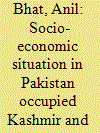| Srl | Item |
| 1 |
ID:
086750


|
|
|
|
|
| Publication |
2009.
|
| Summary/Abstract |
Under which conditions and to what extent do governments pursue unpopular social policy reforms for which they might be punished in the next election? This article shows that there exists substantial cross-cabinet variation in the degree to which governments take unpopular measures and argues that current studies cannot adequately explain this variation. Using insights from prospect theory, a psychological theory of choice under risk, this study hypothesises that governments only engage in unpopular reform if they face a deteriorating socio-economic situation, a falling political position, or both. If not, they shy away from the risk of reform. A fuzzy-set Qualitative Comparative Analysis (fs/QCA) of the social policy reform activities pursued by German, Dutch, Danish and British cabinets between 1979 and 2005 identifies a deteriorating socio-economic situation as necessary for unpopular reform. It is only sufficient for triggering reform, however, if the political position is also deteriorating and/or the cabinet is of rightist composition. This study's findings further the scholarly debate on the politics of welfare state reform by offering a micro-foundation that helps one to understand what induces political actors aspiring to be re-elected to engage in electorally risky unpopular reform.
|
|
|
|
|
|
|
|
|
|
|
|
|
|
|
|
| 2 |
ID:
128516


|
|
|
|
|
| Publication |
2013.
|
| Summary/Abstract |
in 1947 the combined population of Pak-occupied Kashmir (POK) and the 'Northern Areas" of Gilgit and Baltistan was 25 percent of the total population of ]&K State. Today this percentage has gone upto 33 percent of the total population of ]&K. The per decade growth rate of the population on both sides of the Line of Control (LoC) has remained the same. The steep rise in population in POK is because of the heavy in?ux of Punjabi Muslims from the plains. Today the Punjabi Muslims outnumber the Kashmiris in POK by a ratio of 5:1. Not only is 'Azad Kashmir' not Azad (free) - it hardly remains Kashmir except in name. Taking a cue from what the Chinese did in Tibet - the Pakistani Army has followed suit in POK - it has flooded the area with Punjabi Muslims to outnumber the Kashmiris in their own land. Most of the new Punjabi Muslim settlers were former soldiers of the Pakistani Army sent on a simple mission -
colonise Pakistan Occupied Kashmir, stamp out its Kashmiri identity all together, make it 'Pak' (which in Urdu means pure) by making it fully Punjabi. The grass always looks greener on the other side of the hill. It is a great tragedy that the strident propaganda of the jihadis has created a smoke screen that obfuscates the simple truth. Today we need to look across the LoC to see what is the reality. Not only is 'Azad Kashmir' no longer Kashmiri anymore in terms of demographic numbers, it never really was 'Azad' or free. In 1991, POK Prime Minister, Mumtaz Rathore was dismissed, arrested and flown by helicopter to a Pakistani prison.
|
|
|
|
|
|
|
|
|
|
|
|
|
|
|
|